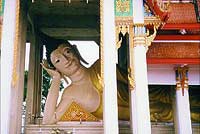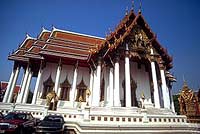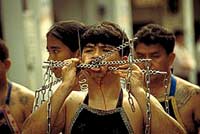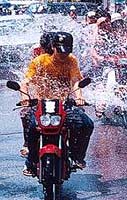|

|
 |

Most classical Thai art originated in or under
the patronage of the royal courts. It is an blend of the finest cultural
tradition of Asia, molded and stamped into unique forms instantly recognizable
as Thai. Classical art encompasses Buddhist art as represented in religious
architecture, decorative murals, and Buddha images.  The art reflects the complex formal structure and etiquette of court culture
with its heavy Indian influences.
The art reflects the complex formal structure and etiquette of court culture
with its heavy Indian influences.
Another category is popular art, which arose from age old village realities
and the rites associated with birth, death, and the seasonal cycle of
crop cultivation. When speaking of Thai art in general one is able to
distinguish between these two groups.
The Sino-Portuguese Architecture of Phuket Town
The significant Sino-Portuguese buildings
of Phuket were built in the tin mining era. First influences came from
Chinese architecture, showing in the design of the roof including doors
and windows. The buildings were mainly one- or two-story buildings made
from brick and wood. They had thick walls with Chinese-style tiles.
 Later
influences included Chino-Portuguese and Malayan styles originating from
Penang. Also Western styles contributed to the distinctive Sino-Portuguese
architecture, including the compositions of the classic Renaissance and
neo-Europe classic with the mixture of Chinese and Thai style architecture. Later
influences included Chino-Portuguese and Malayan styles originating from
Penang. Also Western styles contributed to the distinctive Sino-Portuguese
architecture, including the compositions of the classic Renaissance and
neo-Europe classic with the mixture of Chinese and Thai style architecture.
This new building architecture is about 60 to 100 years old. One of the
charming of these house style is the use of the arch in their architectural
design. Curing pillars standing in row are on the first floor of each
building, to carry the weight of the second floor and to mark the space
of arcade or Nlgorkakee (Chinese for "pavement with roofs").
Temples
 Giant Buddha Statues - Not as famous as Phuket's
temples, but perhaps more interesting because of their obscurity, are
Phuket's two giant Buddha images. Housed at samnagsong, or meditation
centers, rather than at temples, these two massive sculptures are famous
among Thais and almost unknown to tourists. Giant Buddha Statues - Not as famous as Phuket's
temples, but perhaps more interesting because of their obscurity, are
Phuket's two giant Buddha images. Housed at samnagsong, or meditation
centers, rather than at temples, these two massive sculptures are famous
among Thais and almost unknown to tourists.
Both giant statues were built to grace temples built by Luang Boo Kantisilo,
a 100 year old life-long monk and world-famous meditation teacher who
has chosen to make his final home on Phuket. 
 Wat
Chalong is located on the airport bypass road north of the traffic
circle at Chalong. Even though Wat Chalong is the temple with the biggest
influx of tourists, it is still far from crowded. This temple is the most
elaborate and famous on the island, revered for being the site of resistance
to an invasion by Haw Chinese in the nineteenth century. The temple underwent
refurbishment in 1993, and today it is a stunning example of traditional
Thai architecture and décor, colorful and vivid. To this day, Wat Chalong
is famous for its healing powers and Thai people from all over the country
flock to this place in order to regain their physical and spiritual powers. Wat
Chalong is located on the airport bypass road north of the traffic
circle at Chalong. Even though Wat Chalong is the temple with the biggest
influx of tourists, it is still far from crowded. This temple is the most
elaborate and famous on the island, revered for being the site of resistance
to an invasion by Haw Chinese in the nineteenth century. The temple underwent
refurbishment in 1993, and today it is a stunning example of traditional
Thai architecture and décor, colorful and vivid. To this day, Wat Chalong
is famous for its healing powers and Thai people from all over the country
flock to this place in order to regain their physical and spiritual powers.

 Wat
Patong - Patong Beach, the hustling and bustling tourist area on Phuket's
western coast has its own Buddhist temple, surprisingly big in size and
not too well known by the tourists. It is a most impressive icon of the
city and the best time to visit the temple of Patong is in the late afternoon,
when the light of the setting sun shines in the thousands of golden ornaments. Wat
Patong - Patong Beach, the hustling and bustling tourist area on Phuket's
western coast has its own Buddhist temple, surprisingly big in size and
not too well known by the tourists. It is a most impressive icon of the
city and the best time to visit the temple of Patong is in the late afternoon,
when the light of the setting sun shines in the thousands of golden ornaments.

Wat Phra Nang Sang - With more than 200 years, the Wat Phra Nang
Sang in Thalang is the oldest Buddhist temple on the island, built to
a time as Thalang was still the capital of Phuket. The place, where the
temple stands is of historic interest, because the battle with the Burmese
invaders in 1785, a crucial date in the history of Phuket, took place
right here. Legend says, that the Burmese tried to invade Phuket, because
the temple owns ancient manuscripts, who show the location of a buried
treasure. These manuscripts, of a religious nature rather than this more
worldly one, are called Lai Tong and are folded like an accordion –
the Wat Phra Nag Sang claims to have the longest of whole Thailand. 
Wat Phra Tong - Wat Phra Thong, located on Thepkasatri Road in
Thalang, is besides Wat Chalong the second most important temple on Phuket,
but its fame is derived by a magic Buddha statue and not from the healing
powers of a monk. The presiding Buddha statue is believed to be solid
gold within a layer of plaster. In a seated position and exposed up to
the middle of the chest, it stands two meters tall, suggesting a full
height of four meters.
A legend says, that it popped up from the ground and was discovered by
a young boy, who bound his water buffalo on a metal shaft sticking in
the ground, really the Buddha's crown, which was the only part of the
image above ground at that time. Shortly thereafter, the boy fell ill
and died. A vision of his father told the people of the village, that
the metal shaft was really a Buddha image, but the villagers could not
excavate more than the upper half of the statue. Then they built a ordination
hall (bot) around it.
1785, the invading Burmese army tried to dig out the image, too, but a
horde of bees attacked them vigorously and they fled. A cast of cement
and plaster was placed over the image to prevent further attempts to remove
it and so the image is still left there half buried in the middle of the
bot. Nobody knows who made the image or why it was buried, but legend
says that from the day of discovery, dire misfortune has befallen everyone
who has ever tried to dig it up. 
Festivals
Magha Puhja - "Maghapuhja" is a
pali (and sanskrit) word consisting of two elements - Magha and puhja,
which means "the third lunar month" and "worship"
respectively. So, the whole word means "worship on the full-moon
day of the third lunar month in commemoration of the Great Assembly of
Disciples".
 According to Buddhist scriptures, nine months after Siddhartha Gautama
attained enlightenment on the full-moon day of the third lunar month in
the year 587 B.V., a total of 1.250 disciples of the Buddha from various
places spontaneously assembled at Wat Veluvan in Magadha to pay their
respects to their teacher.
According to Buddhist scriptures, nine months after Siddhartha Gautama
attained enlightenment on the full-moon day of the third lunar month in
the year 587 B.V., a total of 1.250 disciples of the Buddha from various
places spontaneously assembled at Wat Veluvan in Magadha to pay their
respects to their teacher.
The date of the festival varies annually, according to the lunar calendar.
In 2000 it was on February 19th. 
Visakha Bucha - This is the holiest of all annual Buddhist religious
days. It marks the birth, enlightenment, and death of the Lord Buddha.
As on Magha Puhja, temples throughout the country are crowded with people
who listen to sermons by revered monks. In the evening there is a solemn
candlelight procession around the main monastery building. The date of
the festival varies annually, according to the lunar calendar. In 2000
it is on May 17th. 
Asaraha Bucha - On the full-moon of the eighth lunar month the
Buddhas first sermon after attaining Enlightenment more than 2.530 years
ago is celebrated. There are evening candlelight processions in all Thai
Buddhist temples.
The date of the festival varies annually, according to the lunar calendar.
In 2000 it is on July 16th. 
Chinese Vegetarian Festival - Every year on the first day of the
ninth month of the Chinese calendar (usually in late September or early
October), the inhabitants of Phuket of Chinese ancestry commit themselves
to a nine-day vegetarian diet.
 The
followers of the custom insist that by doing so, spirit and body are cleansed,
that participants will gain great merit and that the subsequent year will
be trouble-free. The
followers of the custom insist that by doing so, spirit and body are cleansed,
that participants will gain great merit and that the subsequent year will
be trouble-free.
On the first day the gods, spirits and ghosts are begged to grant their
merciful assistance to the people. After dark on the fifth and sixth day,
believers gather at different locations to run over glowing charcoal.The
participants running over glowing charcoal suffer no burns on the soles
of their feet.
On the morning of the eighth and ninth day there are again processions
throughout the entire town. Contrary to the procession on the first day,
blood is shed. Several participants pierce different parts of their bodies
with iron needles and occasionally even with lances up to four meters
long.
Loi Krathong Festival - One of the more picturesque festivals celebrated
at October and November is the Night of the Floating Candles, Loi
Krathong, on the night of the full moon of the twelfth lunar month (this
year it was on October 21st). Loi means to float and krathong is a leaf
cup normally made of banana leaf. There is also a lotus flower, a burning
candle and several incense sticks. A common belief is that floating the
cups brings good luck and drives out the bad ghosts that have arrived
during the previous year. Also, people send their good wishes and promise
to change bad habits as the boat floats downstream.
In the evening, when the full moon begins to rise, people carry their
krathongs to the banks of the waterways. After the candle and incense
sticks are lighted, the krathong is pushed gently out onto the surface
of the placid water. A few folk will raise their hands in worship. They
watch the krathong as it floats sluggishly along until it is out of sight.
 Songkran
Festival - The Thai New Year, is by far the most important event of
the year for the Thai people on Phuket.Songkran peaks on the 13th of April,
but the activities run a couple of days on each side. Songkran
Festival - The Thai New Year, is by far the most important event of
the year for the Thai people on Phuket.Songkran peaks on the 13th of April,
but the activities run a couple of days on each side.
Songkran is a time for cleaning the house thoroughly and for families
to get together. It is a day for promises to be made and an occasion for
general merrymaking.
Anyone who ventures out on the streets is likely to come home soaking
wet, since people splash ice water on one another in abundance but all
in a spirit of fun, welcome at the peak of the hot season. The people
arm themselves with buckets and water hoses and line up on road sides
to wait for pedestrians, motorcyclists and cars to pass by. In the spirit
of the day, everything can be drenched with water and have perfumed talcum
paste smeared all over it. Of course, the tourists are not spared from
the fun, everybody should be aware of that. You should put all valuables
in a plastic bag, not go out with a camera that is not water-proof, wear
old shoes and clothes that can take a soaking. Drivers should make sure
to keep their windows shut, since the interior upholstery can suffer water
damage. By keeping these few safety rules in mind, Songkran will be an
unforgettable and colorful exotic event for you! 
|
